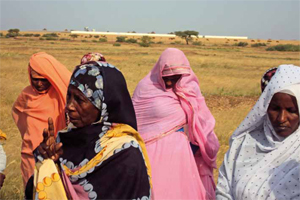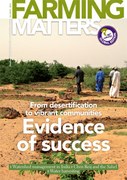Livestock production is the most important economic activity in the Butana region of eastern Sudan. In this region, women of the town of As-Subagh took the initiative to improve their community’s fodder production – while at the same time helping to restore degraded lands in their area. They have been supported by the Butana Integrated Rural Development Project (BIRDP), implemented by the Government of Sudan and IFAD.

Like most of Sudan, Butana experiences erratic rainfall, high temperatures and strong winds. Traditionally, herds grazed freely. However, an increase in livestock populations over recent years, together with the presence of nomadic pastoralists from South Sudan and fluctuating rainfall patterns, has contributed to the severe deterioration of grazing resources. This led to the collapse of the existing economic resource base, particularly affecting sedentary farmers, who lost a substantial number of animals.
In 2006, to support these farmers, the local government fenced a large area of land close to As-Subagh, trying to protect it from erosion. This was to serve as a demonstration plot to build awareness about environmental degradation and the need for natural resource protection, conservation and restoration. The fence was also intended to protect the area against unwanted grazing, allowing space for the cultivation of crops. However, no additional activities were carried out and, eventually, large portions of the fence were looted or dismantled, leaving the land unused and unprotected.
A new approach
In 2010, BIRDP staff in As-Subagh were restoring the fences, when something unexpected happened. Eight women, most of them divorced or widowed, approached them and asked about the project’s intentions, and about the possibility of using the enclosed land. Erosion and the degradation of their land had forced them to stop cultivating sorghum and they relied on a herd of just a few small ruminants.
After a series of meetings, an agreement was made giving each woman the right to use a one-acre plot inside the fence to produce fodder. The women pledged to contribute to the enclosed land’s original purpose and had the opportunity to increase their own income. They began growing a combination of native species and a few recently introduced exotic species. BIRDP supplied kick-start seed and goats to the women, and constructed permanent water harvesting structures to supply the plots. The women were invited to attend training courses on seed collection, extraction and storage, and micro-project planning and management. With the support of BIRDP, the group registered as a legal entity, a step that helped them get financial support and allowed them to further diversify their activities. To avoid any potential conflict, the project also conducted an intensive gender sensitisation programme within the broader community, aimed at encouraging greater levels of women’s participation in the community’s activities and decision-making processes.
Stronger animals, environment and community
Each woman harvested and stored a substantial quantity of dry matter for fodder after the end of the growing season, to be used during the critical dry months. The fenced land not only benefited the group of women, but became a major source of rangeland seeds for natural dispersion and regeneration, both inside and outside the fence, helping surrounding communities as well. The Local Commissioner was so enthusiastic that he led a campaign to replicate and scale up this initiative.
With access to these plots, the women were not only able to feed their animals: they also fed their families and made an income from selling surplus animals, seeds and fodder. In addition, by cultivating and protecting the fenced land in a well organised manner, the women’s social standing in the community has grown considerably. Soon, BIRDP assisted with the formation of two other women’s groups, who collectively work on and protect land plots close to their settlements. Traditionally, men in this region controlled all the resources. Now, women in Butana are playing a larger role.
Success factors
By forming a group, the Butana women have been able to share the responsibility of protecting their fenced plots in a socially and culturally acceptable way. They organised themselves in two day-time shifts, allowing the other women in the group to take care of the young children and family elders in their neighbours’ absence. Mobile phones were purchased with their increased incomes and this made it easier to patrol the large fenced area. Patrols were made more enjoyable by inviting neighbouring women into the enclosed land for coffee and incorporating a special local rite as part of their daily routine.
The women’s knowledge of livestock rearing was especially important, and BIRDP’s staff have drawn upon this. Their participation was crucial; they took the initiative and were motivated to cultivate and protect the land. They pooled the resources needed to address the issues that they themselves deemed important.
The earlier, exclusively technical intervention of building a fence, had negligible results. It was not “rooted” in the community. The later efforts were a success because they paid attention to the importance of community organisations and to the role of women within them. The Butana experience demonstrates that collective production of fodder in a fragile environment can help restore natural resources and improve livelihoods and food security. Moreover, it can be a very successful way to empower female-headed households.
Mohammed ELhassan Ali
Mohammed ELhassan Ali works as Natural Resource Management Officer for the Butana Integrated Rural Development Project (BIRDP), Sudan.
E-mail: mohammedelhassan44@yahoo.com
This article is one of the results of a documentation workshop carried out by ILEIA and KariaNet in 2012 in Beirut, Lebanon, which was supported by the IDRC and IFAD. This workshop aimed to strengthen the skills of project staff in capturing, analysing and disseminating lessons drawn from their work in the field. For more information, visit www.ileia.org and www.karianet.org

